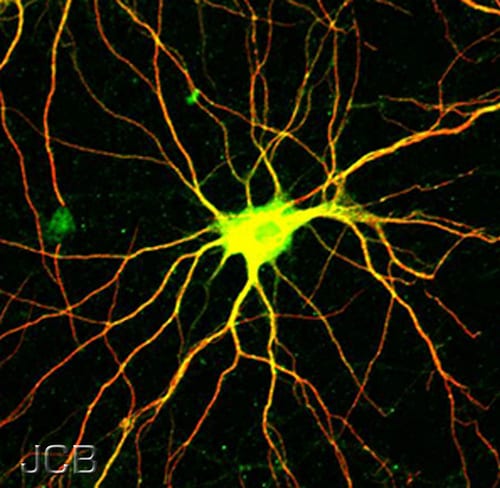
Odde explained that microtubules play an important role in the growth of axons in neurons. Source: Journal of Cell Biology
As part of the Biological Sciences Department Seminar Series, David Odde from the University of Minnesota spoke about different ways to model cell polarization, which involved theatrical dancers as well as computer and mathematic formulas.
Cell polarity refers to the spatial variations in the shape, structure, and function of cells, such as a gradient in protein concentration or a difference in microtubule density. Odde explained that microtubules play an important role in the growth of axons in neurons, Microtubules are part of the cytoskeleton, which is important for cell structure Microtubules alternate between elongating and shortening as they grow. The rapid shortening is due to a loss of more stable building blocks at the end of the microtubule, which exposes the unstable parts that make up most of the structure. The shortening is referred to as a microtubule “catastrophe.” Odde and his team modeled the details of microtubule behavior in axon growth.
As microtubules randomly elongate and shorten when they grow, they occasionally grow so short that they leave the axon. Through this “cell length-dependent model,” Odde and his team explained why there is a higher concentration of microtubules in axons: as microtubules randomly lengthen and shorten around the cell, the microtubules that find their way out into an extending axon, will continue to grow longer. Since the rate of microtubule growth is the same throughout the cell, the areas with lower rates of loss, such as the axon, will see greater concentrations over time.
Odde has also investigated bicoid concentration gradients in cell cytoplasm. Bicoid is a maternal effect gene that is important in patterning of anterior body parts in the fruit fly embryo. Odde believes that the old diffusion model of how biocoids spread throughout the cell is outmoded because the presumed rate of production and destruction of bicoids is too rapid. Instead, Odde theorized that that adding and removing phosphorous groups from bicoids could achieve the concentration gradient of bicoids in the cell, thereby modulating their movement. Compared to the diffusion model, Odde’s model would require a smaller production of bicoids.
Odde drew inspiration from his theory of large molecular behavior from the Black Label Movement (BLM), a dance theater company located in Twin Cities. In an unlikely collaboration between biology and theater, Odde and BLM’s Artistic Director Carl Flink created the “The Moving Cell Project,” in which the BLM dancers served as physical models for molecules within a cell. By giving the dancers simple rules regarding how fast they could move depending on where they were located and later analyzing where the eight dancers spent their time, Odde managed to show that his predictions for the mechanisms of the concentration gradient could give the expected results. The model allowed Odde and other researchers to test model assumptions through computer simulations and analyzed them with relative ease.